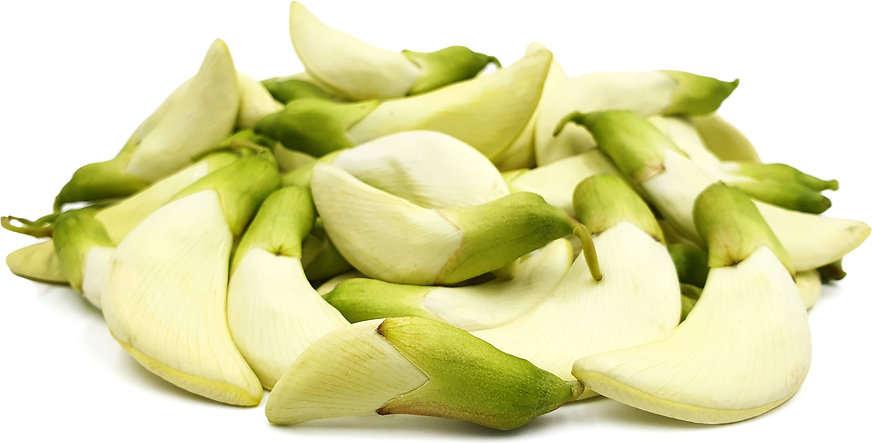


White Sesbania Flowers
Estimated Inventory, ea : 0
Description/Taste
White Sesbania flowers are oblong-shaped, pendulous blooms. They are similar in shape to pea flowers, bearing an upright standard petal; a curved, boat-shaped keel; and wing petals that spread out from the flower. Each flower is quite large, growing to 7 to 10 centimers long. They are showy blooms, and have white, pink or red petals, depending on the variety. However, the white flowers are preferred for eating. The flowers are rich in sugar, and taste sweet at first bite. They also have an intriguing mushroom-y umami flavour, along with a slight bitter aftertaste.
Seasons/Availability
White Sesbania flowers are available in the summer months.
Current Facts
White Sesbania flowers are botanically classified as Sesbania grandiflora, and belong to the pea family. They are also known as Tiger Tongue flowers, Parrot flowers, White Dragon, Australian Corkwood flowers, Swamp Pea. The tree on which White Sesbania flowers grow is not cultivated species. White Sesbania flowers are known as Dok Khae in Thailand, and as Katuray in the Philippines. The flowers can be found in small markets when they are in season.
Nutritional Value
White Sesbania flowers contain protein, carbohydrates, and fiber. They are a source of minerals such as calcium, magnesium, potassium, iron, thiamine, riboflavin, niacin and ascorbic acid.
Applications
White Sesbania flowers are commonly used in salads and curries, such as the sour Kaeng som curries of Thailand. They may be dipped in batter and fried in the same manner as zucchini flowers. To use the flowers, the stamen must first be pulled out as this is bitter in taste. They are then washed, and often quickly blanched before being used. They pair well with seasonings like fish sauce and shrimp paste and go well with other vegetables like green beans, cabbage and tomatoes. To store White Sesbania flowers place them in a loose plastic bag in the refrigerator, where they will last for up to a week.
Ethnic/Cultural Info
White Sesbania flowers grow on the Hummingbird tree, which is very well known in India, where it is known as Akkathi or Agati. The leaves, pods and young shoots are also used as food. White Sesbania flowers are used medicinally, and are said to be cooling and astringent, and to have anti-cancer and antimicrobial effects. They are used to treat headaches, head congestions, bronchitis, digestive problems, tumors and liver disorders. The flowers are usually juiced, or cooked into a soup, and drunk warm. The flowers may also be dried and turned into a powder, then used with curdled milk to treat dry, cracked skin. White Sesbania flowers are also said to be holy to the god Shiva.
Geography/History
The exact origin of White Sesbania flowers is unknown. The plant is believed to have first grown in India or Southeast Asia. It is a tropical plant that can be found in Thailand, Vietnam, Myanmar, Indonesia and the Philippines. It grows wild along roadsides and is commonly found in dikes between rice paddies. It is a plant commonly cultivated in home vegetable gardens. The plant can now be found growing in South and Central America, as well as parts of Australia and the United States.
Recipe Ideas
Recipes that include White Sesbania Flowers. One
| Kitchen Archives |
|
Agasthya Phulla Upkari- A Stir-Fry of Good Health (Vegan & Gluten Free) |
| Chestnut Herbs |
|
Herbal Flowered Persimmon Goat Cheese |




